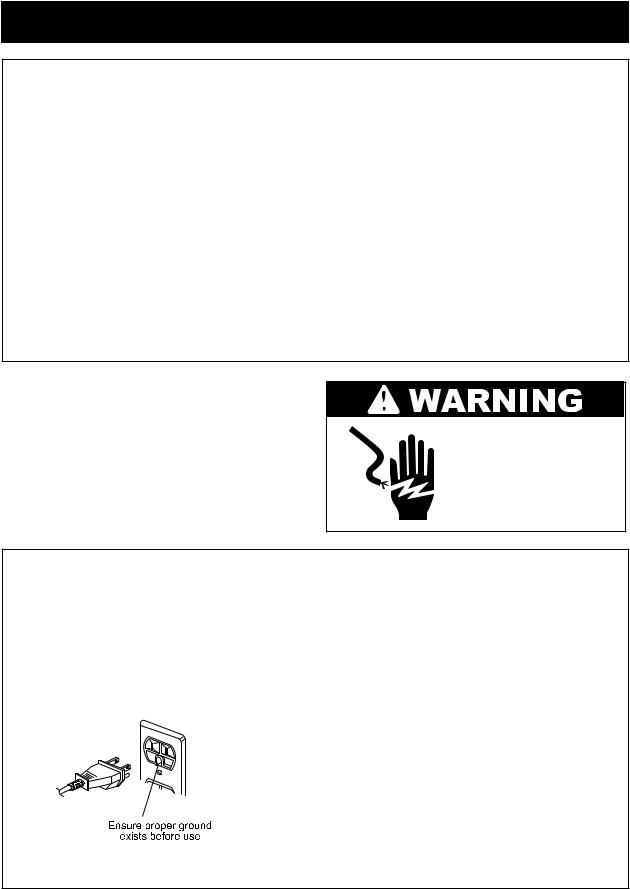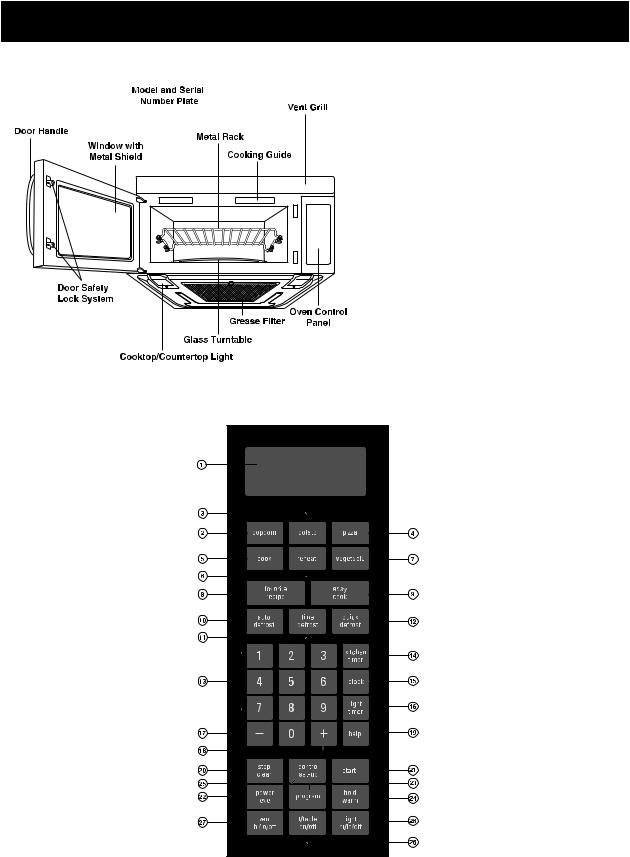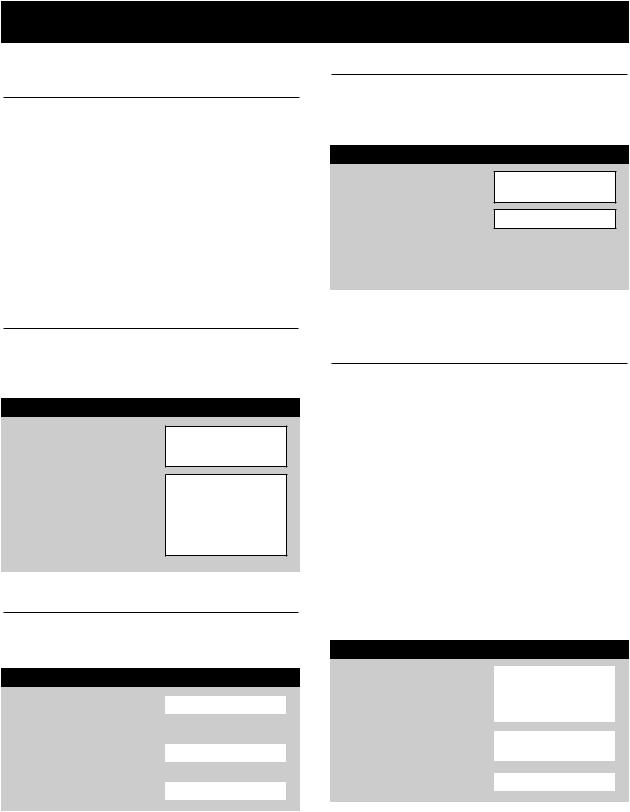Siemens HF36V306, HF36V305 User Manual

Over the Range Microwave
Use and Care Manual
Models: HF36V305, HF36V306
Please read instructions before using.
Important: Save these instructions.
Installer: Please these Instructions with this unit for the owner.
Owner: Please retain these instructions for future reference.
Siemens. forward thinking

TABLE OF CONTENTS
SAFETY ............................................................... |
3-5 |
Precautions To Avoid Possible Exposure |
|
To Excessive Microwave Energy.............................. |
3 |
Important Safety Instructions.............................. |
4-5 |
Grounding Instructions .......................................... |
5 |
UNDERSTANDING YOUR |
|
MICROWAVE OVEN.............................................. |
6-9 |
Cookware Guide .................................................... |
6 |
Tips For Microwave Cooking................................... |
7 |
Parts And Accessories ............................................ |
8 |
Control Panel...................................................... |
8-9 |
USING YOUR MICROWAVE OVEN..................... |
10-29 |
Learn About Your Microwave Oven ...................... |
10 |
Help .................................................................... |
10 |
Clock................................................................... |
10 |
Kitchen Timer...................................................... |
10 |
Control Set-Up..................................................... |
10 |
Vent HI/LO/Off ..................................................... |
11 |
T/Table On/Off ..................................................... |
11 |
Child Lock............................................................ |
11 |
Light HI/LO/Off..................................................... |
11 |
Light Timer.......................................................... |
11 |
Easy Cook............................................................ |
12 |
Hold Warm .......................................................... |
12 |
Favorite Recipe .................................................... |
12 |
+/– (More/Less).................................................... |
12 |
Cooking At High Power Level ............................... |
13 |
Cooking At Lower Power Level............................. |
13 |
Cooking With More Than One Cook Cycle............. |
13 |
Cooking Guide For Lower Power Level.................. |
14 |
Sensor Operating Instructions.............................. |
15 |
Sensor Cooking Guide.......................................... |
15 |
Adding Or Subtracting Cook Time........................ |
15 |
Popcorn............................................................... |
15 |
Pizza.................................................................... |
16 |
Potato.................................................................. |
16 |
Vegetable............................................................. |
16 |
Cook.................................................................... |
17 |
Reheat................................................................. |
17 |
Auto Defrost........................................................ |
18 |
Weight Conversion Chart ..................................... |
18 |
Defrosting Tips .................................................... |
18 |
Auto Defrost Chart.......................................... |
19-20 |
Time Defrost ....................................................... |
21 |
Quick Defrost....................................................... |
21 |
Use Of The Two Position Metal Rack..................... |
21 |
Time Defrost Chart .............................................. |
22 |
Getting The Best Cooking Results......................... |
22 |
Fish And Shellfish ................................................ |
23 |
Fish And Shellfish Cooking Table.......................... |
23 |
Appetizers/Sauces/Soups...................................... |
24 |
Meat.................................................................... |
24 |
Meat Cooking Table............................................. |
25 |
Poultry................................................................. |
26 |
Poultry Cooking Table.......................................... |
26 |
Pasta And Rice..................................................... |
27 |
Pasta Cooking Table............................................. |
27 |
Rice Cooking Table............................................... |
27 |
Care And Cleaning................................................ |
28 |
Metal Rack............................................................ |
28 |
Cleaning The Grease Filter .................................... |
28 |
Charcoal Filter Replacement.................................. |
28 |
Cooktop/Night Light replacement.......................... |
29 |
Oven Light replacement........................................ |
29 |
TROUBLE SHOOTING........................................ |
30-31 |
Before Calling For Service .................................... |
30 |
Questions And Answers....................................... |
31 |
2

 SAFETY
SAFETY
PRECAUTIONS TO AVOID POSSIBLE
EXPOSURE TO EXCESSIVE
MICROWAVE ENERGY
(a)Do not attempt to operate this oven with the door open since open-door operation can result in harmful exposure to microwave energy. It is important not to defeat or tamper with the safety interlocks.
(b)Do not place any object between the oven front face and the door or allow soil or cleaner residue to accumulate on sealing surfaces.
(c)Do not operate the oven if it is damaged. It is particularly important that the oven door closes properly and that there is no damage to the:
(1)Door (bent),
(2)Hinges and latches (broken or loosened),
(3)Door seals and sealing surfaces.
(d)The oven should not be adjusted or repaired by anyone except properly qualified service personnel.
FEDERAL COMMUNICATIONS COMMISSION RADIO FREQUENCY INTERFERENCE STATEMENT ( U.S.A. ONLY)
 WARNING:
WARNING:
This equipment generates and uses ISM frequency energy and if not installed and used properly, that is in strict accordance with the manufacturer’s instructions, may cause interference to radio and television reception. It has been type tested and found to comply with limits for ISM Equipment pursuant to part 18 of FCC Rules, which are designed to provide reasonable protection against such interference in a residential installation.
However, there is no guarantee that interference will not occur in a particular installation. If this equipment does cause interference to radio or television reception, which can be determined by turning the equipment off and on, the user is encouraged to try to correct the interference by one or more of the following:
•Clean door and sealing surface of the oven.
•Reorient the receiving antenna of the radio or television.
•Relocate the Microwave Oven with respect to the receiver.
•Move the microwave oven away from the receiver.
•Plug the microwave oven into a different outlet so that the microwave oven and the receiver are on different branch circuits.
The manufacturer is not responsible for any radio or TV interference caused by unauthorized modification to this microwave oven. It is the responsibility of the user to correct such interference.
3

 SAFETY
SAFETY
IMPORTANT SAFETY INSTRUCTIONS
The safety instructions below will tell you how to use your oven and avoid harm to yourself or damage to your oven.
 WARNING - To reduce the risk of burns, electric shock, fire, injury to persons, or exposure to excessive microwave energy:
WARNING - To reduce the risk of burns, electric shock, fire, injury to persons, or exposure to excessive microwave energy:
•Read all the instructions before using your oven.
•Do not allow children to use this oven without close supervision.
•Read and follow the specific PRECAUTIONS TO
AVOID POSSIBLE EXPOSURE TO EXCESSIVE MICROWAVE ENERGY found on page 3.
•Do not use corrosive chemicals or vapors, such as sulfide and chloride, in this appliance. This type of oven is specifically designed to heat, cook, or dry food. It is not designed for industrial or laboratory use.
•Do not use or store this appliance outdoors. Do not use this product near water (for example, near a kitchen sink, in a wet basement near a swimming pool, or similar location.)
•Do not use the cavity for storage purposes. Do not leave paper products, cooking utensils or food in the cavity when not in use.
•Clean the ventilating hood frequently. Do not allow grease to accumulate on the hood or the filters.
•Use care when cleaning the vent hood filters. Corrosive cleaning agents such as lye-based oven cleaners may damage the filters.
•Do not tamper with the built-in safety switches on the oven door. The oven has several built-in safety switches to make sure the power is off when the door is open.
•Always turn fan on HIGH when cooking foods that might flame up, or any time flames occur on the cooktop.
•Suitable for use above both gas and electric cooking equipment 36 inches wide or less.
•Do not use this oven for commercial purposes. It is made for household use only.
•When cleaning the door and the surfaces that touch the door, use only mild, non-abrasive soaps or detergents and a sponge or soft cloth.
•If your oven is dropped or damaged, have it thoroughly checked by a qualified service technician before using it again.
•To avoid a fire hazard:
-Do not severely overcook food. Severely overcooked foods can start a fire in the oven. Watch the oven carefully, especially when you have paper, plastic, or other combustibles in the oven.
-Do not store combustible items (bread, cookies, etc.) in the oven, because if lightning strikes the power lines it may cause the oven to turn on.
-Do not use wire twist-ties in the oven. Be sure to inspect purchased items for wire twist-ties and remove them before placing the item in the oven.
•If a fire should start inside the oven:
-Keep the oven door closed.
-Turn the oven off.
-Disconnect the power cord or shut off the power at the fuse or circuit breaker panel.
•To avoid electric shock:
-This appliance must be grounded. Connect the oven only to a properly grounded outlet. See the
electrical GROUNDING INSTRUCTIONS on page 5.
-Do not operate this appliance if it has a damaged cord or plug, if it is not working properly, or if it has been damaged or dropped.
-Do not immerse the electrical cord or plug in water.
-Keep the cord away from heated surfaces.
•To avoid improperly cooking some foods:
-Do not heat any types of baby bottles or baby food.
Uneven heating may occur and possibly cause personal injury.
-Do not heat small-necked containers, such as syrup bottles.
-Do not deep-fat fry in your microwave oven.
-Do not attempt home canning in your microwave oven.
-Do not heat the following items in the microwave oven: whole eggs in the shell, water with oil or fat, sealed containers, or closed glass jars. These items may explode.
•Do not cover or block any openings in the oven.
•Use your oven only for the operations described in this manual.
•Do not run the oven empty, without food in it.
•Do not let cord hang over edge of table or counter.
•Preserve the oven floor:
-Do not heat the oven floor excessively.
-Do not allow the gray film on special microwave-cook- ing packages to touch the oven floor. Put the package on a microwavable dish.
4

 SAFETY
SAFETY
- Do not cook anything directly on the oven floor or |
HOT LIQUIDS SUDDENLY BOILING OVER WHEN THE |
|
turntable. Use a microwavable dish. |
CONTAINER IS DISTURBED OR A SPOON OR OTHER |
|
- Keep a browning dish at least 3/16 inch above floor. |
UTENSIL IS INSERTED INTO THE LIQUID. |
|
Carefully read and follow the instructions for the |
|
|
To reduce the risk of injury to persons: |
||
browning dish. If you use a browning dish incorrectly, |
you could damage the oven floor. |
- Do not overheat the liquid. |
|
|
||
• Install or locate this appliance only in accordance with |
- Stir the liquid both before and halfway through |
|
the provided installation instructions. |
||
heating it. |
||
|
||
• This appliance should be serviced only by qualified |
- Use extreme care when inserting a spoon or other |
|
service personnel. Contact the nearest authorized ser- |
||
utensil into the container once heating has begun. |
||
vice facility for examination, repair or adjustment. |
||
- Do not use straight-sided containers with narrow |
||
• Liquids such as water, coffee, or tea are able to be over- |
||
necks. |
||
heated beyond the boiling point without appearing to |
||
- After heating, allow the container to stand in the |
||
be boiling. Visible bubbling or boiling when the |
||
microwave oven for a short time before removing the |
||
container is removed from the microwave oven is |
||
container. |
||
not always present. THIS COULD RESULT IN VERY |
||
|
||
SAVE THESE INSTRUCTIONS |
||
Electrical requirements
Observe all governing codes and ordinances. A 120 Volt, 60 Hz, AC only, 15 or 20 amp fused electrical supply is
required. (A time-delay fuse is recommended.) It is recommended that a separate circuit serving only this appliance be provided.
ELECTRICAL SHOCK HAZARD Plug into a grounded 3 prong outlet. Do not remove ground prong. Do not use an adapter. Do not use an extension cord.
Failure to follow these instructions can result in death, fire, or electrical shock.
GROUNDING INSTRUCTIONS
• For all cord connected appliances:
The microwave oven must be grounded. In the event of an electrical short circuit, grounding reduces the risk of electric shock by providing an escape wire for the electric current. The microwave oven is equipped with a cord having a grounding wire with a grounding plug. The plug must be plugged into an outlet that is properly installed and grounded.
WARNING: Improper use of the grounding can result in a risk of electric shock.
Consult a qualified electrician or serviceman if the grounding instructions are not completely understood, or if doubt exists as to whether the microwave oven is properly grounded. Do not use an extension cord. If the power supply cord is too short, have a qualified electrician or serviceman install an outlet near the microwave oven.
• For a permanently connected appliance:
The microwave oven must be connected to a grounded, metallic, permanent wiring system, or an equipment grounding conductor should be run with the circuit conductors and connected to the equipment grounding terminal or lead on the microwave oven.
SAVE THESE INSTRUCTIONS
5

UNDERSTANDING YOUR MICROWAVE OVEN
COOKWARE GUIDE
Most heat-resistant, non-metallic cookware is safe for use in your microwave oven. However, to test cookware before using, follow these steps:
1.Place the empty cookware in the microwave oven.
2.Measure 1 cup of water in a glass measuring cup and place it in the oven beside the cookware.
3.Microwave on 100% power for 1 minute. If the dish is warm, it should not be used for microwave cooking.
USE |
DO NOT USE |
|
|
|
|
Ovenproof Glass |
Metal Utensils |
|
•Glass treated for use in high-intensity heat includes |
•Metal shields food from microwave energy and |
|
utility dishes, bread dishes, pie plates, cake plates, |
produces uneven cooking. Avoid metal skewers, ther- |
|
liquid measuring cups, casseroles, and bowls without |
mometers, or foil trays. |
|
metallic trim. |
•Metal utensils can cause arcing, which is a |
|
China |
discharge of electric current. Arcing can damage your |
|
microwave oven. |
||
•Bowls, cups, serving plates, and platters without |
||
Metal Decoration |
||
metallic trim can be used in your oven. |
||
Plastic |
•Do not use metal-trimmed or metal-banded |
|
dinnerware, casserole dishes, etc. |
||
•When using plastic wrap as a cover, make sure that |
||
CenturaTM Tableware |
||
the dish is deep enough so the plastic wrap does not |
||
touch the food. As the food heats, it may melt the |
•The Corning Company recommends that you do not |
|
plastic wrap wherever the wrap touches the food. |
use Centura tableware and some CorelleTM closed- |
|
•Place plastic wrap loosely over the top of the dish |
handle cups for microwave cooking. |
|
and secure it by pressing the wrap to the sides of the |
Aluminum Foil |
|
dish. |
||
•Vent by turning back one corner of the plastic wrap. |
•Avoid large sheets of aluminum foil because they hin- |
|
This will allow excess steam to escape. |
der cooking and may cause arcing. |
|
•Use plastic dishes, cups, semi-rigid freezer |
•Use small pieces of foil to shield poultry legs and |
|
containers, and plastic bags only for short time |
wings. |
|
cooking. Use these with care because the plastic |
•Keep all aluminum foil at least 1 inch from the walls |
|
may soften from the heat of the food. |
and door of the oven. |
|
Paper |
Wood |
|
•Microwave-safe paper towels, waxed paper, paper |
•Wooden bowls, boards, and baskets will dry out and |
|
napkins, and paper plates with no metallic trim or |
may split or crack when you use them in the micro- |
|
design can be used in your oven. |
wave oven. |
|
•Refer to the manufacturer’s label for use of any paper |
Tightly Closed Containers |
|
product in the microwave oven. |
||
|
•Tightly closed cookware can explode. Be sure to leave |
|
|
an opening for steam to escape from covered cook- |
|
|
ware. |
|
|
Brown Paper |
|
|
•Avoid using brown paper bags. They absorb heat and |
|
|
could burn. |
|
|
Metal Twist Ties |
|
|
•Always remove metal twist ties as they can become |
|
|
hot and cause a fire. |
|
|
|
6

UNDERSTANDING YOUR MICROWAVE OVEN
TIPS FOR MICROWAVE COOKING
BROWNING
Meat and poultry with high fat content will brown lightly when cooked for 10 or 15 minutes or longer. Foods cooked a shorter time can be brushed with a browning agent, such as Worcestershire sauce, soy sauce, or barbecue sauce.
COVERING
A cover traps heat and steam and causes the food to cook more quickly. Use a lid or microwave-safe plastic wrap with one corner folded back to vent the excess steam. Lids on glass casseroles can become hot during cooking. Handle carefully. Waxed paper will prevent the food from splattering in the oven and help retain heat. When warming bread items, use waxed paper, napkins, or paper towels. To absorb extra moisture, wrap sandwiches and fatty foods in paper towels.
SPACING
Arrange individual foods, such as baked potatoes, cupcakes, and hors d’oeuvres in a circle and at least 1 inch apart. This will help the food cook more evenly.
STIRRING
Stirring blends flavors and redistributes the heat in foods. Always stir from the outside toward the center of the dish. Food at the outside of the dish heats first.
TURNING
Large foods, such as roasts and whole poultry, should be turned during cooking so that the top and bottom cook evenly. Also turn over chicken pieces and chops.
ARRANGEMENT
Do not stack food. Arrange in a single layer in the dish for more even cooking. Because dense foods cook more slowly, place thicker portions of meat, poultry, fish, and vegetables toward the outside of the dish.
TESTING FOR DONENESS
Because foods cook quickly in a microwave oven, you need to test frequently for doneness.
STANDING TIME
Food often needs to stand from 2 to 15 minutes after cooking inside as well as outside the oven. Usually, you need to cover food during standing time to retain heat. Stop the cooking when they are slightly undercooked and they will finish cooking during standing time. The internal temperature of food will rise about 10  F during standing time.
F during standing time.
SHIELDING
To prevent some portions of food in rectangular or square dishes from overcooking, you may need to cover the dish with small strips of aluminum foil to block the microwaves. You can also cover poultry legs and
wing tips with foil to keep them from overcooking.
Always keep foil at least 1 inch from oven walls to prevent arcing.
PIERCING
Pierce the shell, skin, or membrane of foods before cooking to prevent them from bursting. Foods that require piercing include yolks and whites of eggs, hot dogs, clams, oysters, and whole vegetables such as potatoes and squash.
CLEANING
Wipe the oven inside and outside with a soft cloth and a mild detergent solution. Then rinse and wipe dry. This should be done weekly or more often, if needed. Never use cleaning powders or rough pads. Excessive oil splatters on the inside top will be difficult to remove if left for many days. Wipe splatters with a wet paper towel, especially after cooking chicken or bacon.
REMOVABLE PARTS
The turntable and turntable roller rest are removable. They should be hand-washed in warm (not hot) water with a mild detergent and a soft cloth. Once they are clean, rinse well and dry with a soft cloth. Never use cleaning powders, steel wool, or rough pads.
•The turntable may be cleaned in the sink. Be careful not to chip or scratch the edges as this may cause the turntable to break during use.
•The turntable roller rest should be cleaned regularly.
SPECIAL CARE
For best performance and safety, the inner door panel and the oven front frame should be free of food or grease buildup. Wipe often with a mild detergent; then rinse and wipe dry. Never use cleaning powders or rough pads.
After cleaning the control panel, touch stop/clear to clear any entries that might have been entered accidentally while cleaning the panel.
7

UNDERSTANDING YOUR MICROWAVE OVEN
PARTS AND ACCESSORIES
OVEN SPECIFICATIONS
Power Supply |
120 VAC, 60 Hz |
|
|
Input Power |
1,500 W |
|
|
Cooking Power |
1,000 W |
|
(IEC 60705 Standard) |
|
|
Frequency |
2,450 MHz |
Rated Current |
13 A |
Outer Dimensions |
(WxHxD) |
|
2915/16” x 167/16”x 155/8” |
Cavity Volume |
1.8 Cu. Ft. |
Net Weight |
60 lbs. |
|
|
CONTROL PANEL
• See page 9 for control panel features.
8

UNDERSTANDING YOUR MICROWAVE OVEN
CONTROL PANEL FEATURES
NOTE: Styling and features vary by model.
1.Display: The Display includes a clock and indicators to tell you time of day, cooking time settings and cooking functions selected.
2.Popcorn: Touch this pad when popping popcorn in your microwave oven. The oven’s sensor will tell the oven how long to cook depending on the amount of humidity it detects from the popcorn. See page 15 for more information.
3.Potato: Touch this pad to cook potatoes. The oven’s sensor will tell the oven how long to cook depending on the amount of humidity it detects from the potato. See page 16 for more information.
4.Pizza: Touch this pad to reheat pizza. The oven’s sensor will tell the oven how long to cook depending on the amount of humidity it detects from the pizza. See page 16 for more information.
5.Cook: Touch this pad to cook frozen entrees, casserole and rice. The oven’s sensor will tell the oven how long to cook depending on the amount of humidity coming from the food. See page 17 for more information.
6.Reheat: Touch this pad to reheat casseroles, dinner plates and soup or sauce. The oven’s sensor will tell the oven how long to cook depending on the amount of humidity coming from the food. See page 17 for more information.
7.Vegetable: Touch this pad to cook vegetables. The oven’s sensor will tell the oven how long to cook depending on the amount of humidity it detects from the vegetables. See page 16 for more information.
8.Favorite recipe: Touch this pad to recall one cooking instruction previously programmed into memory. See page 12 for information.
9.Easy cook: Touch this pad to set and start quickly at 100% power level. See page 12 for more information.
10.Auto defrost: Meat, poultry, fish. Touch this pad to select food type and defrost food by weight. See page 18 for more information.
11.Time defrost: Touch this pad to defrost most other frozen foods. See page 21 for more information.
12.Quick defrost: This pad provides Quick defrosting for 1.0 pound of frozen foods. See page 21 for more information.
13.Numbers: Touch number pads to enter cooking time, power level, quantities, or weights.
14.Kitchen timer: Touch this pad to set the kitchen timer. See page 10 for more information.
15.Clock: Touch this pad to enter the time of day. See page 10 for more information.
16.Light timer: Touch this pad to set the light timer. See page 11 for more information.
17.– (Less): Touch this pad to subtract ten seconds of cooking time each time you press it. See page 12 for more information.
18.+ (More): Touch this pad to add ten seconds of cooking time each time you press it. See page 12 for more information.
19.Help: Touch this pad to learn how to use each oven function. See page 10 for more information.
20.Stop/clear: Touch this pad to stop the oven or to clear all entries.
21.Start: Touch this pad to start a function. If you open the door after oven begins to cook, touch start again.
22.Power level: Touch this pad to select a cooking power level. See page 13 for more information.
23.Program: Touch this pad to set a cooking time. See page 13 for more information.
24.Hold warm: Touch this pad to keep hot, cooked foods warm in your microwave oven for up to 99 minutes and 59 seconds. See page 12 for more information.
25.Control set-up: Touch this pad to change the oven’s default settings for sound, clock, display speed and defrost weight from Lbs to Kg.
See page 10 for more information.
26.T/table on/off: Touch this pad to turn off the turntable. OFF will appear in the display. See page 11 for more information.
NOTE: This option not available in sensor cook and defrost modes.
27.Vent hi/lo/off: Touch this pad to turn the fan on or off. See page 11 for more information.
28.Light hi/lo/off: Touch this pad to turn on the cooktop/countertop light. See page 11 for more information.
9

USING YOUR MICROWAVE OVEN
LEARN ABOUT YOUR
MICROWAVE OVEN
This section discusses the concepts behind microwave cooking and introduces you to the basics you need to know to operate your microwave oven. Please read this information before use.
 CAUTION
CAUTION
•To avoid risk of personal injury or property damage, do not run oven empty.
•To avoid risk of personal injury or property damage, do not use stoneware, aluminum foil, metal utensils, or metal trimmed utensils in the oven. See page 6 for details.
HELP
The Help pad displays feature information and helpful hints. Press Help, then select a key pad.
Example: To learn about the popcorn feature. PROCEDURE DISPLAY
1.Touch help pad.
2.Touch popcorn pad.
TOUCH THIS KEYPAD THEN THE DESIRED FEATURE
TOUCH THIS KEYPAD TO POP MICROWAVE POPCORN THE DISPLAY WILL SHOW SENSING UNTIL REMAINING COOK TIME HAS BEEN CALCULATED
CLOCK
This oven includes a 12-hour clock.
Example: To set 8:00 AM.
|
PROCEDURE |
|
DISPLAY |
1. |
Touch clock pad. |
|
|
AM ENTER TIME OF DAY |
|||
|
(Press once for AM, |
|
|
|
|
|
|
|
twice for PM) |
|
|
2. |
Touch number keypad |
|
|
8 |
: 00 TOUCH START |
||
3. |
[8], [0] and [0]. |
|
|
|
|
||
Touch start pad. |
|
|
|
8 |
: 00 |
||
KITCHEN TIMER
You can use your microwave oven as a timer. Use the Timer for timing up to 99 minutes and 59 seconds.
Example: To time 3 minutes.
PROCEDURE
1.Touch kitchen timer pad.
2.Touch number keypad
[3], [0] and [0].
3.Touch start pad.
DISPLAY
ENTER TIME IN MIN AND SEC
3 : 00 TOUCH START
Timer and time counting down.
•When the time is over, you will hear seven beeps and END will display.
CONTROL SET-UP
You can change the default values for beep sound, clock, display speed and defrost weight. (LBS/KG) See following chart for more information.
No. |
Function |
No. |
Result |
1 |
Sound ON/OFF |
1 |
Sound ON |
|
control |
2 |
Sound OFF |
2 |
Clock ON/OFF |
1 |
Clock ON |
|
control |
2 |
Clock OFF |
3 |
Scroll Speed |
1 |
Slow speed |
|
control |
2 |
Normal speed |
|
|
3 |
Fast speed |
4 |
LBS/KG choice |
1 |
Lbs. |
|
control |
2 |
Kg. |
|
|
|
|
Example: To change defrost weight mode from Lbs to Kg.
|
PROCEDURE |
DISPLAY |
1. |
Touch control set-up |
|
SOUND ON/OFF TOUCH 1 |
||
|
pad. |
CLOCK ON/OFF TOUCH 2 |
|
|
SCROLL SPEED TOUCH 3 |
|
|
LBS/KG CHOICE TOUCH 4 |
2. |
Touch number [4] pad. |
|
LBS TOUCH 1 |
||
|
|
KG TOUCH 2 |
3. |
Touch number [2] pad. |
|
KG |
||
|
|
|
10
